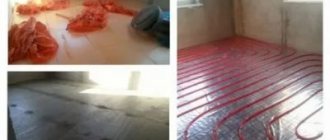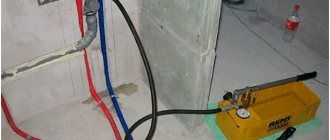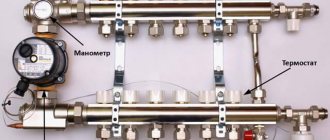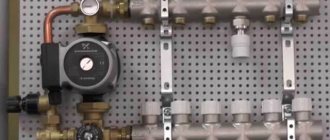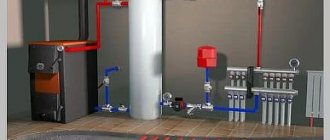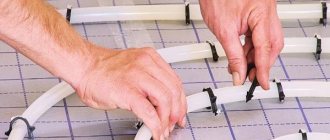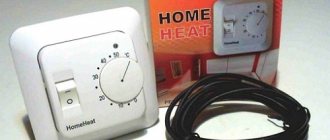- Which coolant is better?
- Water and distilled water
- Distilled water: the best option in a green card home
- Antifreeze
- Crystallization temperature of ethylene glycol-based antifreeze
- Ethylene glycol antifreeze is often pink
Hydronic heating systems—both radiators and underfloor heating—use fluids to transfer heat. And this is not only water, but in most cases (68% of the total system) is used. Antifreeze is also used, as opposed to ethylene glycol and propylene glycol based antifreeze. They have also added additives that reduce reactivity to improve other properties of these fluids. You can get acquainted with the production of coolants on the company’s website https://teplonositeli-pro.ru
Which coolant to choose for floor heating.
For heated floors, you can use the same configuration that is poured into the radiator system, but check compatibility with heated floors before purchasing. The properties of antifreeze depend on additives, which can be completely different, if you are interested in a complete list of antifreeze properties.
It is even pleasant to relax on a warm floor, no matter what is filled with it.
Before making advance calculations, you need to decide what type of coolant will fill the floor with hot water. In general, all calculations are carried out on water, and when using antifreeze, all properties must be calculated according to their characteristics. For example, the overall pump output should increase by 10-15%, usually the pressure by 60-65%. Low heat transfer of antifreeze, change in circuit length or pipe diameter. In addition, the length of the system must be large in order to transfer the required amount of heat. The type of coolant is also important when choosing equipment and pipes. Not all are compatible with antifreeze, some can be used with antifreeze.
Water and distilled water
If you use regular untreated water, this is, of course, the cheapest and sometimes free option. And it has other advantages.
- Environmentally safe and absolutely harmless to humans. Regular water does not harm people or the environment.
- High heat capacity. This is the only liquid that can carry too much heat, and just as importantly, it can work well.
- It is easy to replenish lost volumes. Once any water has leaked or evaporated, you can simply add more.
- Possibility of use in all types of systems. With open open expansion tank.
There is nothing greener and safer than water
However, using water as a coolant has its drawbacks. Some of them are somewhat related to the underfloor heating system, they are harmful but not significant:
- Since salts are present in moisture, they are deposited on system components. Even a small amount of precipitation reduces the heat transfer of the heating unit. But underfloor heating is a closed system. That is, the same liquid circulates through a closed pipeline. And since there is not a large amount of salt in the limited amount, there can be no question of serious deposits.
- Due to the presence of oxygen in the water, metal parts of the system may be subject to corrosion. However, oxygen content may be limited. This is done at the pipe selection stage. The product is selected as a low oxygen permeability material or as an additional layer to prevent oxygen penetration. In this case, a small amount of water contains a small amount of oxygen, which quickly binds and does not harm the system components.
- If the system is stopped, the amount of water increases and can damage the pipeline. This is a physical property of water and cannot be obtained anywhere else. But the situation may be critical. Select a plastic pipe. If the volume increases, it will not crash. For example, polypropylene and polyethylene have these properties.
- The water in the underfloor heating system should be changed at least once a year. Antifreeze is changed every 3-5 years. But water is free and antifreeze is ok.
Advantage of electric-water system
With liquid heating, heat is distributed unevenly throughout the room. The longer the circuit, the greater the temperature difference at the outlet of the collector and at the inlet to the boiler.
The floor is laid under a deep screed, up to 8 cm. It is an additional heating element. It is difficult to install water underfloor heating in a city apartment; permission from the housing department is required.
With electric heating, heat is distributed evenly over the entire surface of the floor, but due to the high cost of energy resources, systems are installed only in local areas in the house.
The electric water floor is an autonomous system. A pipeline is formed on the floor from pipes into which coolant is pumped. Its volume in the pipeline is constant. The liquid is heated by electricity. What advantages does this heating system have?
- Due to the electric heating element, the entire floor surface is heated evenly.
- A deep screed is laid on the contour of the “warm floor”, which retains heat for a long time. The system saves 30% electricity.
- The scheme does not require the installation of a boiler, collector and other equipment typical for water underfloor heating.
- The amount of liquid in the pipeline is 4-6 liters. In case of an emergency, flooding of neighbors will not occur.
- Installation of the heating system is carried out quickly with your own hands, without the participation of specialists.
- An electric water floor is suitable for heating any room, regardless of air humidity.
- The interior is installed on the screed without restrictions.
Experts and forum users on online construction sites do not note any significant shortcomings. They warn that when laying the floor line, a step of at least 15 cm must be observed.
Some systems have a cable inside the pipe. The pipe should not be bent too much.
Distilled water: the best option in a green card home
As you can see, it is better to use water as the coolant in your underfloor heating system, and it is a very inexpensive option. To make the system more attractive and almost completely safe, you can pre-treat the coolant. Soften the water The easiest way is to open the lid, put it in a metal pan and cook. In this case, part of the salt precipitates (unstable compounds of potassium and magnesium). But it is impossible to boil and remove stable compounds. It can be removed by adding a little lime, sodium orthophosphate or soda ash. But you can make it easier: use distilled water. If you use this liquid on warm soil, you will automatically eliminate the risk of salt deposits. This is a good choice because there is very little distilled water.
Fluid for heated floors: types, features, advantages and disadvantages
When choosing a water type of heated floor, the question arises, what kind of liquid to choose for the heated floor? Below are the options for the liquid used for heated floors, their features, advantages and disadvantages.
There are three options for floor heating fluid:
- plain water;
- distilled water;
- antifreeze.
Water
This liquid is familiar and has a high heat capacity, making it the most popular choice. However, its use leads to the need for frequent release of excess air, since a certain amount of oxygen is released in the water over time, which in turn accelerates the process of aggressive corrosion.
Water
Distilled water
Purified liquid is always better than ordinary water, since it does not contain harmful impurities that can adversely affect pipes and hoses used in heated floors. For those who do not have a water filter at home, you will have to buy distilled water, which will slightly increase the cost of installing a water floor, but not significantly than if you had to do the cleaning yourself or even drill a well. In addition, distilled water will not leave scale on the pipe walls, which significantly reduces the heat transfer of materials.
Distilled liquid
Antifreeze
A special antifreeze solution has a significant advantage over water - it does not freeze, which is where the name comes from. This is important for those who do not regularly use heated floors in winter. If the temperature drops below normal, unlike ordinary water, antifreeze does not harden, but forms a gel, which subsequently turns back into liquid without losing its beneficial properties.
Antifreeze fluid
Despite the apparent advantage of antifreeze solutions, there are some disadvantages of this liquid for heated floors:
- the liquid is too viscous, which will require additional costs for a more powerful pump;
- The heat capacity of antifreeze is 15% less than water;
- special attention should be paid to sealing connections;
- the need to use a single-circuit boiler.
Antifreeze system
It is also worth noting that if you want to dilute the antifreeze, you will still need the same water, only distilled.
You can buy a special liquid for heated floors from the companies presented below.
The trading company offers a large selection of different coolants for the heating system and has representative offices in Nizhny Novgorod, St. Petersburg, Novosibirsk, Rostov-on-Don, Samara, Voronezh and Chelyabinsk.
- Address:
Moscow, building 3 in 2nd Raushsky Lane - Call here:
+7 (495) 2-042-169 - More details:
https://www.plastgroup.ru/
The company delivers products to different cities. There are representative offices in Nizhny Novgorod, Kazan, Cheboksary and Ulyanovsk.
- Main office address:
Cheboksary, building 11 on Gladkova street - Call here:
(8352) 563-300, (8352) 449-063 - More details:
https://www.k-strategia.ru/
Antifreeze
The heating system uses ethylene glycol and propylene glycol antifreeze. They are typically aqueous solutions of these polyhydric alcohols, and additives are added to improve their properties.
Heating system.
Only special compounds are used in the heating system. Universal antifreeze or a car should not be poured into a warm layer of water.
When choosing antifreeze, remember that ethylene glycol is a strong poison. In drug addiction, 60% of deaths occur, and in the remaining 40%, the kidneys are seriously damaged. The lethal dose for adults is 100-300 ml. Apart from ingestion, contact with skin or mucous membranes has serious consequences. Although toxic, vapor levels are low, but chronic inhalation has irreversible effects. However, antifreeze based on this ethylene glycol is used. They sell 5 times more than the safer and more expensive propylene glycol.
Is it advisable to replace water with glycol?
The answer to this question depends on the operating features of the “Warm Floor” system. If we are talking about an object located in conditions of extremely low temperatures, then it is better to give preference to ethylene glycol antifreeze, which is able to maintain its original performance properties even at 50 degrees below zero.
The main thing is to use special working compounds for climate control equipment in the heating system, and not universal glycol-based automotive antifreezes. If the price factor is of key importance for you, and the risk of the system freezing is minimal, you can get by with demineralized water with a package of special additives. Anti-corrosion additives in antifreeze reduce the oxidizing ability of the liquid, so there is no need to worry about the integrity of equipment and pipes.
Crystallization temperature of ethylene glycol-based antifreeze
Ethylene glycol is not ideal as a coolant due to all its risks.
- Highly corrosive (much higher than water). Suitable inhibitors are used to reduce corrosiveness.
- It has the ability to foam, which is again compensated for by appropriate additives.
- More liquid than water causes leakage problems. Due to the toxicity of ethylene glycol, this can be a problem. It is necessary to work with liquids, paying attention to protective gloves and goggles. In addition, all objects and substances that absorbed the solution are toxic. They are subject to replacement and destruction.
- Ethylene glycol does not react well to overheating. When the temperature rises to 70°C, active precipitation occurs, which significantly reduces the heat transfer of the thermal device. And this again leads to overheating. After overheating, the properties of the liquid change dramatically, which makes the antifreeze impossible to continue working. According to this criterion, it should be noted that in systems with solid fuel boilers, ethylene glycol-based antifreeze cannot be used: without 95 ° C more regularly than without, and without automation to control the position of the heat exchanger, it inevitably overheats.
Characteristics of "XL Pipe"
The XL Pipe electric-water floor system is installed both in large cottages and in country houses with a small heated area. It consists of the following elements:
- a pipe made of heat-resistant polymer, inside of which there is a heating element;
- the coolant in it is heated by an eight-core cable; it connects to the network;
- the liquid for heated floors is introduced manually; use propylene glycol or antifreeze;
- when heated, the coolant expands, so the tube is equipped with a pressure absorption chamber;
- the inlet end is covered with a silicone cap; it has holes for the electrical cable;
- the ends of the cable are placed in a chamber with insulating material;
- The main line is laid under a screed 4-5 cm deep.
We recommend: What concrete is suitable for a warm water floor?
Before installing the main, preparatory work is carried out: leveling the floor surface, laying waterproofing and insulation. A damper tape is reinforced along the lower perimeter of the wall. If mats for “warm floors” are not used, then a reflective screen and reinforced mesh are laid on the insulation. The liquid circuit is attached to it.
All preparatory work is carried out with your own hands. To connect the liquid line, it is recommended to contact specialists.
Pipes are laid in a “snail” or “snake” pattern. The end of the pipe is not returned to the connection point. It is placed in any convenient place on the floor.
When forming a screed, the mesh provides additional reinforcement. Copper wire is attached to the fittings; grounding is carried out.
A temperature sensor is placed between the turns of the cable. It is placed in a protective case. All wires are checked for resistance, connected to the network, and placed in a junction box located on the floor. It is closed with a screed.
The cable to the thermostat comes out of the box. It is installed at a distance of 70 cm from the floor. The end of the temperature sensor and the heating system are connected to it. The thermostat controls and operates the heating system.
Features of antifreeze for floor heating systems
H2_2
The non-freezing liquid that fills the heating circuit does not change its physical state and qualities when exposed to low temperatures. This composition is capable of efficiently transporting thermal energy through the heating system. The main property of a non-freezing liquid is that it does not harden or thicken when exposed to low temperatures.
Under such conditions, non-freezing liquid does not expand and is not capable of destroying the components and elements of the heating system - when severely frozen, it takes the form of a gel-like mass, the volume of which remains unchanged. If the temperature rises, the antifreeze will turn from a gel-like substance into a liquid, which will not entail negative consequences for the heating circuit.
The antifreeze liquid for water heated floors contains anti-corrosion inhibitors that effectively eliminate the accumulation of rust and scale in pipes. Manufacturers produce antifreezes that can withstand temperatures ranging from -60 -30 °C.
If necessary, the concentration of the composition is changed - the non-freezing liquid is diluted with distilled water in a ratio of 1:2. So, for example, a liter of antifreeze, which is designed for the lowest temperature (-60 ° C), is diluted with 0.5 liters of water. After this, the composition will be suitable for work at temperatures up to 30-35°C.
The antifreeze composition used in underfloor heating pipes has a limited service life; on average, it is used for 10 heating seasons, after which it is replaced.
The non-freezing coolant used in water heated floor systems, along with its advantages, also has certain disadvantages:
- The heat capacity of this composition is 15-20% lower than that of water, therefore the heat transfer of antifreeze is worse.
- The viscosity level of such a coolant for water-based floor heating systems is very high, which requires connecting a powerful circulation pump to the heating circuit.
- Due to the high volumetric expansion of the antifreeze liquid when heated, it is necessary to install a closed expansion tank and heating radiators with increased capacity.
- Antifreeze has a high fluidity compared to water, and to prevent leaks, all connections in the warm water floor circuit must be carefully sealed.


